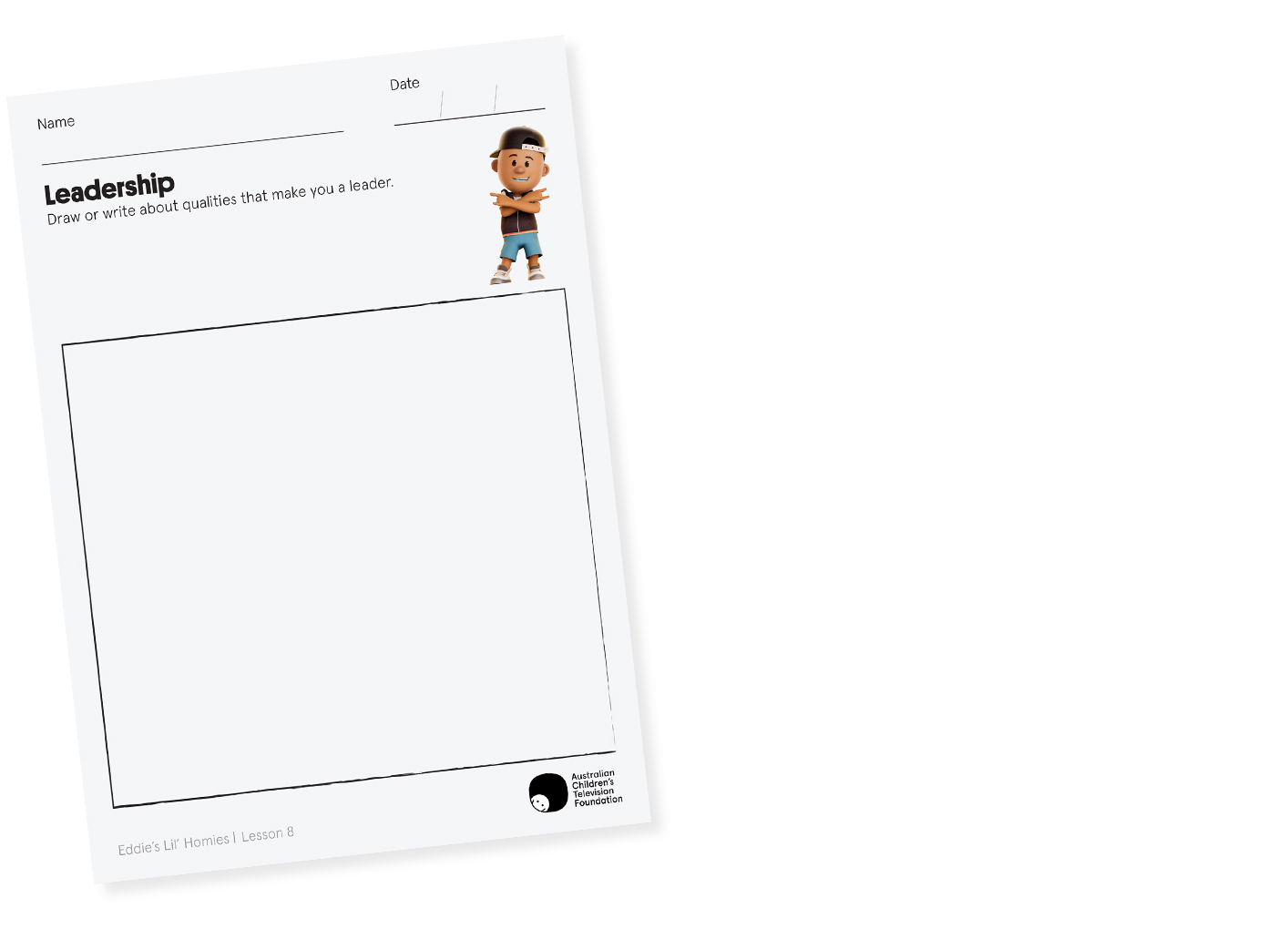In this lesson, we are learning to:
- Define and understand what leadership means.
- Describe different leadership styles.
- Identify our leadership qualities.
In this lesson, we are learning to:
Episode: ‘Pling Plong’ – A new playground craze takes over the playground and Eddie finds himself a stranger in a strange land.
Find ‘Pling Plong’ on NITV, Netflix or SBS On Demand.

‘We’ve got to help Junior!’ – Eddie
Assign students to groups. Ask each group to brainstorm games and toys that are currently or previously popular at school, then choose one of these options to perform for the class. Hold a game of charades, with each group acting out a scene while peers try to correctly guess the game or toy.
In this Eddie’s Lil’ Homies episode, a new game called ‘Pling Plong’ has become the latest playground craze. As the self-appointed ‘King Plong’, Junior invents the rules and dictates who is allowed to play. He enjoys this social power and is hoping to remain King Plong forever. Meanwhile, Eddie doesn’t even know how to play the game, but he demonstrates leadership in different ways. For example, he rescues both Shanti and Junior from tricky situations.
Watch this episode as a class, asking students to focus on examples of leadership. After viewing, invite students to share their observations.
In a class discussion, explain that a leader is someone who can encourage, motivate or inspire other people to achieve a goal. All schools, sports clubs, workplaces and governments have leaders. Sometimes the leader is identified for everyone, like the coach of a basketball team. In other situations, a leader is found when other people start following them – usually because other people are confident in the leader’s knowledge or skills.
Every person has qualities that can be valuable in leadership, such as being positive, empathetic, creative, responsible or a good communicator.
Ask students to turn and talk to a partner about the leaders in their own lives. They could be Elders, student leaders, sports coaches, teachers and principals, religious leaders and more. What makes these people good leaders?
Different leaders have different ‘leadership styles’. This refers to the ways that leaders motivate other people to reach a goal. Some leaders give the group instructions, or a leader can model behaviours as an example, or leaders can work with others, asking everyone questions to make decisions as a team.
Prompt the class to reflect on and discuss the different leadership styles of Eddie and Junior. Who was most effective at guiding other people? Is one leadership style better than the other? Why?
Assign students into small groups. As a hands-on collaborative task, challenge each group to invent a fun new game using equipment from the classroom or playground. After adequate planning time, ask each group to present their game idea to the class. Ask each group to speak about:
To enable students to demonstrate their understanding of leadership, have students complete the provided worksheet (see PDF). They will draw and/or write about their own leadership qualities.

|
|
Foundation |
Year 1 |
Year 2 |
Transfer knowledge |
Connect ideas and information between familiar learning experiences. |
Use ideas and information from a previous experience to inform similar learning experiences. |
|
|
|
Foundation |
Year 1 |
Year 2 |
Literature |
AC9EFLE02Respond to stories and share feelings and thoughts about their events and characters.AC9EFLE04Explore and replicate the rhythms and sound patterns of literary texts such as poems, rhymes and songs.AC9EFLE05Retell and adapt familiar literary texts through play, performance, images or writing. |
AC9E1LE02Discuss literary texts and share responses by making connections with students’ own experiences.AC9E1LE04Listen to and discuss poems, chants, rhymes and songs, and imitate and invent sound patterns including alliteration and rhyme.AC9E1LE05Orally retell or adapt a familiar story using plot and characters, language features including vocabulary, and structure of a familiar text, through role-play, writing, drawing or digital tools. |
AC9E2LE02Identify features of literary texts, such as characters and settings, and give reasons for personal preferences.AC9E2LE04Identify, reproduce and experiment with rhythmic sound and word patterns in poems, chants, rhymes or songs.AC9E2LE05Create and edit literary texts by adapting structures and language features of familiar literary texts through drawing, writing, performance and digital tools. |
Literacy |
AC9EFLY07Create and deliver short spoken texts to report ideas and events to peers, using features of voice such as appropriate volume. |
AC9E1LY07Create and deliver short oral and/or multimodal presentations on personal and learnt topics, which include an opening, middle and concluding statement; some topic-specific vocabulary and appropriate gesture, volume and pace. |
AC9E2LY07Create, rehearse and deliver short oral and/or multimodal presentations for familiar audiences and purposes, using text structure appropriate to purpose and topic-specific vocabulary, and varying tone, volume and pace. |
|
|
Foundation |
Year 1 |
Year 2 |
Personal, social and community health |
AC9HPFP02Practise personal and social skills to interact respectfully with others.AC9HPFP03Express and describe emotions they experience. |
AC9HP2P02Identify and explore skills and strategies to develop respectful relationships.AC9HP2P03Identify how different situations influence emotional responses. |
|
|
|
Foundation |
Year 1 |
Year 2 |
Leadership |
Practise self-leadership by taking responsibility for their own actions. |
Practise ways that they can lead self and others, and describe when it is appropriate to adopt a leadership approach. |
|
Empathy |
Demonstrate an awareness of the needs, emotions, cultures and backgrounds of others. |
Describe similarities and differences between the needs, emotions, cultures and backgrounds of themselves and others. |
|